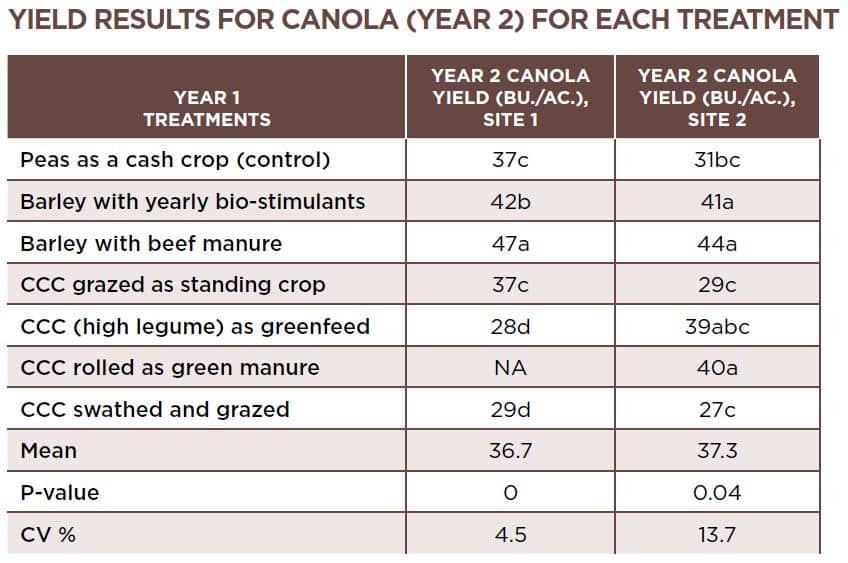Key Result
This study compared seven cropping systems in year one, followed by canola in year two and wheat in year three. On a benefit: cost ratio basis, three treatments – year-one cattle manure, year-one green manure crop, and annual application of bio-stimulants – would perform better than other cropping systems investigated in this study.
Project Summary
Overview
Alberta Agriculture and Forestry’s recent AgriProfit$ report showed that fertilizer costs constitute up to 25 per cent of the total variable costs in cereal production, and up to about 30 per cent for canola. This is compelling producers to seek options that will improve soil nutrients and overall soil health, while reducing fertilizer input expenses, but not sacrificing yield.
In Alberta, integrated crop-livestock systems are receiving renewed interest. Producer motivations are varied, but often include risk reduction through diversification, increased nutrient and land-use efficiency, and climate resilience.
This project was carried out to see how different cropping systems, including a cover crop cocktail of diverse species (CCC), livestock integration, and the use of manure and foliar fertilizer could improve soil health, fertility savings, and carbon storage over a three-year period on two soil types – grey soils at Fairview in the northwest and brown soils at Sedalia
in the east.
The seven cropping system options, planted in year one:
- Peas as a cash crop (control)
- Barley with soil rejuvenation program using soil and foliar biostimulants (which were applied all three years)
- Barley with a beef manure application
- CCC grazed as a standing crop
- CCC (high legume percentage)
for greenfeed - CCC rolled as a green manure
- CCC swathed and grazed
After year one, all seven treatments were seeded to canola in year two and wheat in year three.
Results
Generally, greater improvement in grain yield came from cropping treatments with the application of manure in the first year, the use of a CCC as green manure, and the annual application of bio-stimulants for seed treatment and foliar application.

P-value for cropping treatment x yield. P of less than 0.05 (or 19+ out of 20) is ideal; NA, data not available.
Canola yield was significantly influenced by prior cropping treatments at both sites, with the beef manure and barley in year one producing the highest seed, followed by barley with the annual bio-stimulants. At site one (Fairview), only these two treatments produced significantly higher seed yield than the control. At site two (Sedalia), those two treatments plus the CCC as green manure clearly showed significantly higher seed yield than the control.
On a benefit:cost ratio basis, the application of manure in year one, the annual application of bio-stimulants, and the use of a CCC mixture for green manure in the first year of a three-year cropping system would perform better than other cropping systems investigated.
In general, all cropping treatments seemed to provide some form of nutrient credit to the system.
Enrichment of soil organic carbon (SOC) through sequestration of atmospheric CO2 in agricultural soils is important because of its impact on soil quality, agronomic production, and mitigation of climate change. In the present study, the treatments did not impact SOC. A long-term study would be required to monitor any improvement in SOC. Previous research showed that a high SOC concentration can be achieved through adoption of appropriate crop rotations, integrated soil fertility management, judicious rates of mineral fertilizers and organic amendments, and conservation tillage methods.





